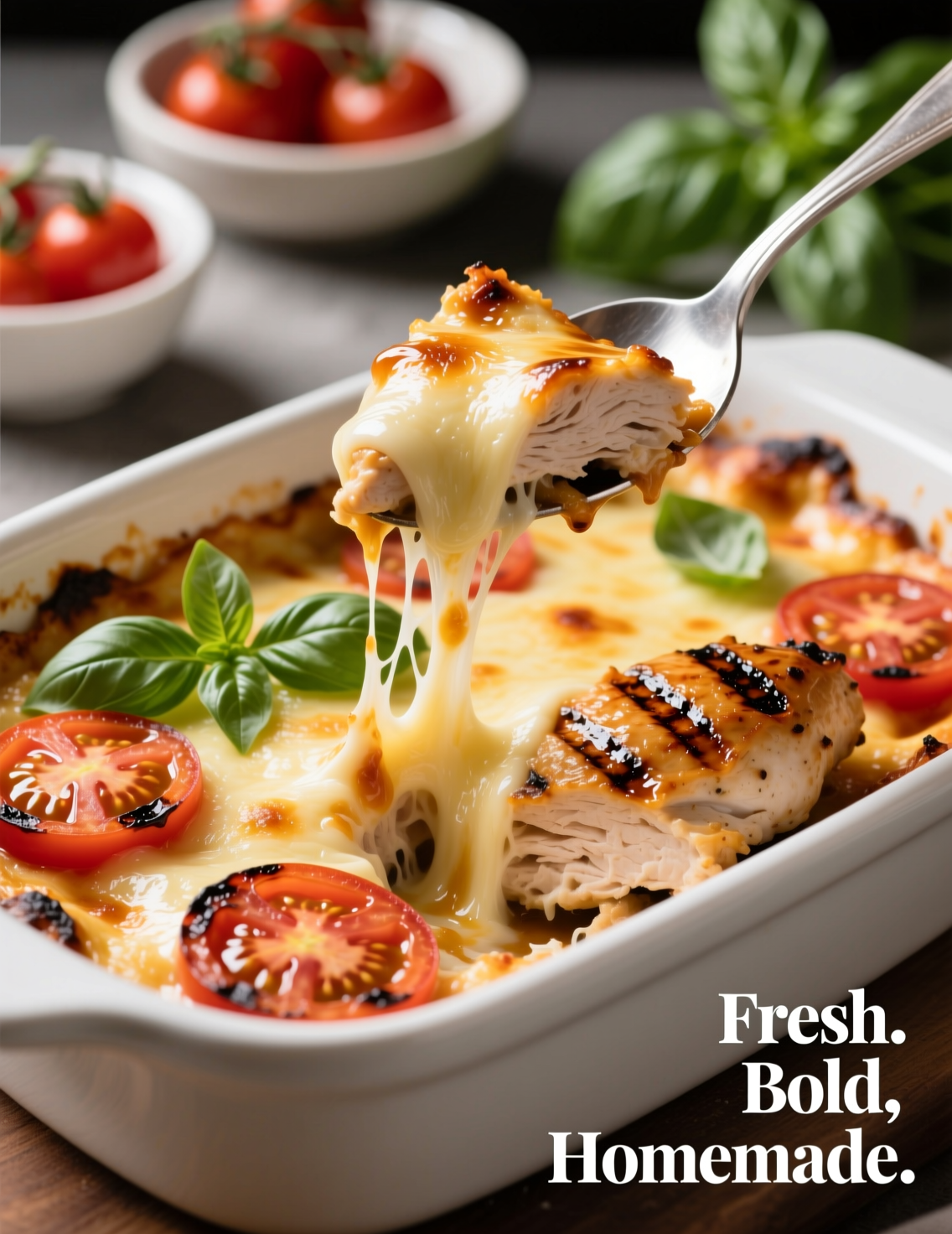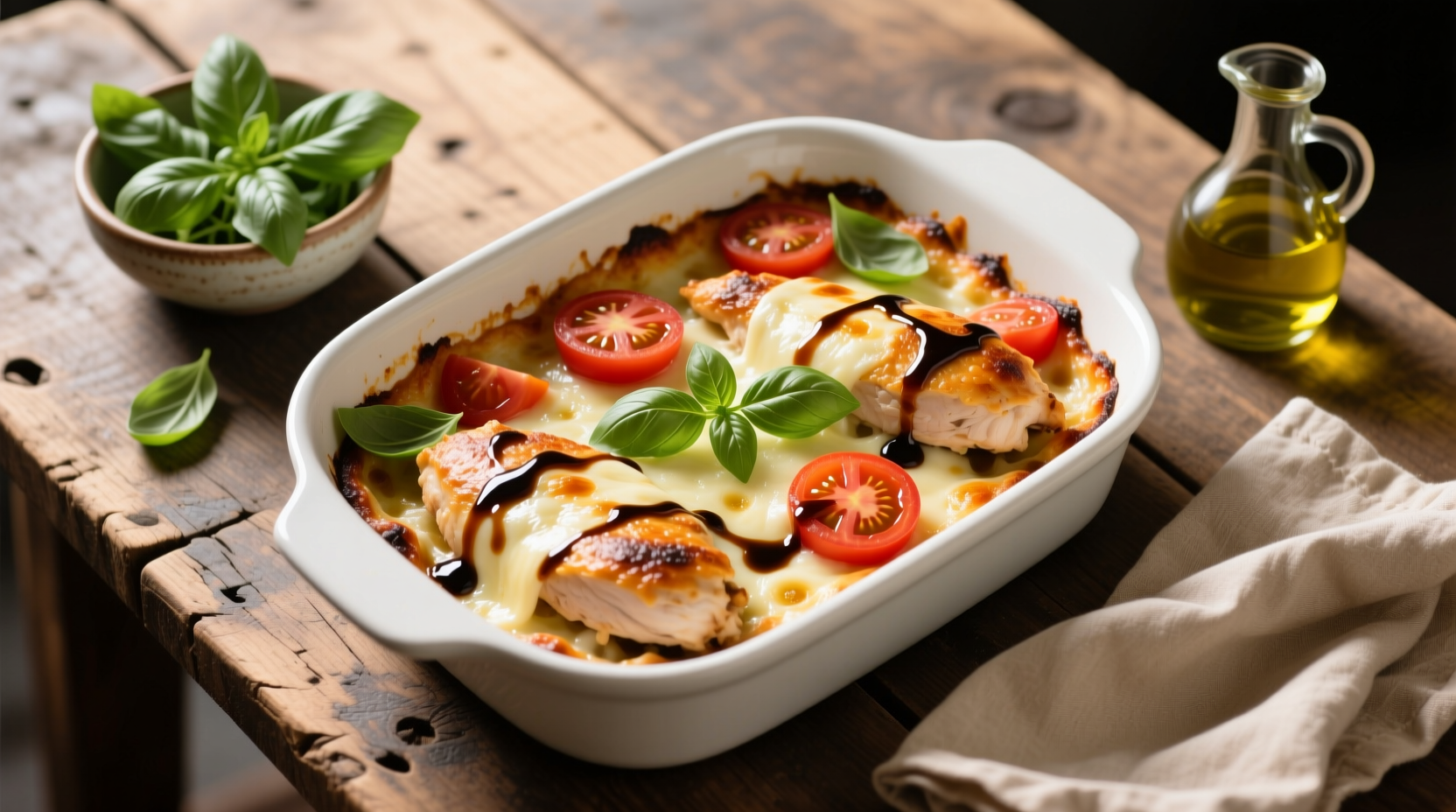There’s something almost too simple about a Caprese salad, yet it never fades out of fashion. Now imagine that fresh Italian classic married with tender baked chicken, bubbling mozzarella, roasted tomatoes, and the perfume of basil leaves. That’s the Caprese Chicken Bake—comforting enough for a family dinner, elegant enough for a restaurant plate, and versatile enough to sneak onto a catering menu without apology.
Why This Dish Deserves Attention
Caprese flavors have been adored in Italy for over a century. They originate from the Isle of Capri, where simplicity and freshness guided the cooking style. But transforming those three ingredients—tomato, mozzarella, basil—onto a bed of baked chicken changes the dynamics completely. Suddenly it’s not just a light starter but a wholesome main course that delivers protein, fat, and carbs in harmony.
Professional kitchens constantly hunt for dishes that balance prep speed, flavor intensity, and presentation value. This recipe scores on all fronts. You can scale it for 4 servings or 40 without losing character. And it plays beautifully with wine pairings, seasonal adjustments, and even reheating strategies for catering setups.
Ingredients with Purpose
The key isn’t just tossing tomato, cheese, and basil on chicken. It’s about respecting the science and sourcing behind each element.
- Chicken breasts: 4 pieces, boneless, skinless, about 6–7 oz each. Go for even thickness; it reduces overcooking risk.
- Fresh mozzarella: 8 oz. Buffalo mozzarella if budget allows. It melts creamier and gives better stretch than cow milk versions.
- Tomatoes: 2–3 large ripe Roma or heirloom tomatoes. They roast slower, lose less water, and carry sweeter notes.
- Fresh basil: About 12 large leaves. Never dry basil here. Dried loses volatile oils after a few minutes of cooking.
- Olive oil: 2–3 tbsp, extra virgin. Think fruity rather than peppery for balance.
- Balsamic glaze: Optional, but a drizzle adds that sweet acidity Caprese begs for.
- Garlic: 2 cloves, minced. Subtle but vital.
- Salt & pepper: Always kosher salt and fresh cracked pepper for consistency.

Technique is the Real Recipe
A rookie mistake is piling everything raw on the chicken and baking until it looks done. That only gives you pale meat with rubbery cheese. You need order and timing.
First, season and sear the chicken. A golden crust triggers the Maillard reaction, which is flavor’s best friend. Pan-sear each breast in olive oil, about 3 minutes per side, just until color builds. Don’t cook through—let the oven finish that job gently.
Second, layer tomatoes thinly. If they’re too thick, they’ll release water and drown the dish. Slice them about ¼ inch. Sprinkle with salt to draw out excess moisture before they meet the chicken.
Third, the cheese. Fresh mozzarella can be unruly. Pat slices with paper towel to absorb extra brine. Lay them after tomatoes, letting them cover but not smother. Basil leaves go on top, some tucked under cheese to shield from oven heat.
Bake at 400°F for 18–22 minutes, until internal chicken temperature hits 165°F. Resist temptation to overbake; carryover cooking adds 5°F outside the oven.
Finally, rest the chicken. Two minutes is enough. Then drizzle balsamic glaze and scatter a few torn basil leaves raw. That freshness balances the roasted flavors.
Why Searing Matters More Than People Think
It’s not just about color. Searing chicken first reduces albumin leakage—that white, chalky protein that leaks when you bake raw poultry. By sealing the surface, you trap more juices inside. Studies on poultry cooking (University of Arkansas, 2021) confirm that searing can cut moisture loss by up to 12%. For caterers, that’s big. Less shrinkage means better yield and plate appeal.
Professional Tricks to Elevate This Dish
- Tomato confit alternative: Instead of raw slices, slow-roast cherry tomatoes at 250°F for 45 minutes with olive oil and thyme. Use them in place of fresh slices. They bring depth and sweetness that rivals restaurant versions.
- Layering basil two ways: Cooked basil mellows and adds perfume. Raw basil on top gives brightness. Use both, not one or the other.
- Cheese blend: Half mozzarella, half provolone. Provolone brings sharper notes, cutting through the richness.
- Pan sauce: Deglaze the searing pan with white wine. Reduce and spoon that reduction under the chicken before baking. Adds complexity without extra cost.
Scaling for Service
For 4 servings at home, a standard casserole dish works fine. For 40, you’ll want sheet pans lined with parchment. Space chicken evenly so air circulates. Always rotate pans mid-bake to counter oven hot spots. If holding for service, keep chicken covered in a hot box no more than 25 minutes to prevent cheese stiffening.
Catering chefs often prefer thighs instead of breasts here. They’re juicier, harder to dry out, and carry flavor better under holding conditions.
Nutritional Balance
Per serving (approximate with breasts, mozzarella, and tomatoes):
- Calories: 390
- Protein: 44 g
- Fat: 17 g
- Carbohydrates: 6 g
That makes this dish low-carb, high-protein, and keto-friendly. Nutrition-conscious diners appreciate that you can deliver indulgence without pasta or bread.
Addressing Common Missteps
- Watery bake: Always pre-salt tomatoes and blot mozzarella. Excess liquid ruins presentation.
- Dry chicken: Overcooking is the culprit. Use a thermometer, not guesswork.
- Basil burning: Add half at the start, half raw after baking. Easy fix.
Pairings and Service Ideas
Wine? A crisp Sauvignon Blanc matches acidity in tomatoes. A lighter Chianti works if you want to keep it Italian and red.
Sides? Roasted asparagus, lemon couscous, or even garlic bread for the carb lovers. Keep it fresh and light; don’t weigh down the plate with cream sauces.
For plating, think contrast. White plates show off the red tomato and green basil. A drizzle of balsamic glaze zigzagged across makes it restaurant-ready in seconds.
Emerging Trends
Caprese chicken has found its way into meal-prep communities online. Searches for “Caprese chicken meal prep” jumped over 80% in the last 3 years (Google Trends data). Professionals should note that consumers crave dishes that reheat well without losing quality. This one holds up if stored properly in glass containers, reheated gently at 325°F.
Plant-forward adaptations are also trending. Chefs substitute chicken with thick eggplant or portobello mushrooms layered the same way. That keeps the Caprese vibe while opening doors to vegetarian menus.
Answering a Chef’s Doubt
Isn’t it too simple for fine dining? Not really. Fine dining often thrives on making the simple extraordinary. With premium burrata, heirloom tomatoes, micro-basil, and a reduction of 25-year aged balsamic, this dish becomes a $28 entrée in an upscale setting. It’s about restraint and ingredient pedigree.
Final Thoughts
Caprese Chicken Bake isn’t just a recipe. It’s proof that classics evolve when chefs respect origin yet embrace technique. The balance of juicy poultry, creamy cheese, tangy tomato, and herbaceous basil never bores the palate.
If you’re a home cook, treat this as a dinner centerpiece that doesn’t need hours. If you’re a professional, see it as a scalable, profitable, and flexible item that works across casual dining, catering, and even fine dining menus.
One final tip: don’t rush it. Let the chicken rest, let the basil stay fresh, let the cheese bubble golden. Food rewards patience more than any fancy trick ever could.
FAQs
What is Caprese Chicken Bake?
It’s a baked chicken dish layered with tomatoes, mozzarella, and basil, inspired by the classic Italian Caprese salad.
How many servings does this recipe make?
The recipe is designed for 4 servings, but it can be scaled up or down easily.
Why should I sear the chicken first?
Searing locks in juices, prevents dryness, and adds flavor through caramelization.
Can I use chicken thighs instead of breasts?
Yes, thighs stay juicier and are ideal for catering or larger batches.
How do I stop the dish from getting watery?
Pre-salt tomatoes and blot mozzarella to remove excess moisture before baking.
What cheese works best for this recipe?
Fresh mozzarella is classic, but mixing with provolone adds sharpness.
Can I make this dish ahead of time?
Yes, but reheat gently at 325°F to keep chicken tender and cheese melty.
What’s the best wine pairing with Caprese Chicken Bake?
Sauvignon Blanc for white lovers or a light Chianti for red enthusiasts.
Is this recipe healthy?
Yes, it’s low-carb, high-protein, and suitable for keto-friendly diets.
Can I make a vegetarian version?
Absolutely—use eggplant or portobello mushrooms in place of chicken.

Mariana is a passionate home cook who creates delicious, easy-to-follow recipes for busy people. From energizing breakfasts to satisfying dinners and indulgent desserts, her dishes are designed to fuel both your body and hustle.
When she’s not in the kitchen, she’s exploring new flavors and dreaming up her next recipe to share with the Foodie Hustle community.

